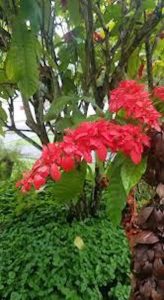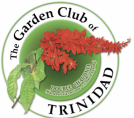Warszewiczia coccinea cv. “David Auyong
The DOUBLE CHACONIA by Johnny Lee
 “Stop the car! Stop the car!” Grace Mulloon must have exclaimed excitedly when she spotted a magnificent, large, scarlet inflorescence among a group of wild Chaconia (Warszewiczia coccinea) down a steep precipice alongside the narrow Blanchisseuse road that meanders through Trinidad’s northern range.
“Stop the car! Stop the car!” Grace Mulloon must have exclaimed excitedly when she spotted a magnificent, large, scarlet inflorescence among a group of wild Chaconia (Warszewiczia coccinea) down a steep precipice alongside the narrow Blanchisseuse road that meanders through Trinidad’s northern range.
The year was 1957 and Mulloon was taking a leisurely drive with fellow naturalist David
Auyong and another friend when they came upon this momentous find: They had discovered the only mutant Chaconia plant of its kind ever found growing in the wild!
Mulloon may have been the first to spot the outstanding bloom, but it is to David Auyong that the world owes a greater debt of gratitude: He saved the plant from extinction, risking life and limb on numerous occasions to obtain suitable material from the almost inaccessible plant for propagation. He eventually succeeded with the help of Roy Nichols, plant physiologist at the Imperial College of Tropical Agriculture (ICTA), to get three new plants established. “Just in the nick of time”, as the saying goes, because, shortly afterwards, the original plant perished during road work exercises.
Dr. Julian Duncan, former professor of botany at the University of the West Indies, explains: “The material was propagated at ICTA from soft stem cuttings, which rooted relatively easily in a sand medium, but the delicate nature of the fine roots made establishment extremely difficult.”
Only one of the three new plants survived, and great care had to be taken to grow it to maturity and then to propagate it. Officially named Warszewiczia coccinea cultivar “David Auyong” and commonly called double Chaconia, all such plants now in existence are descended from this single plant.
With the methods of propagation and culture greatly improving over the years, the double Chaconia has become a common sight in the gardens of Trinidad and Tobago; and no overseas horticultural display of this country now is complete unless it contains some of its exquisite blooms.
NATIONAL FLOWER For most of the rainy season, especially in the month of August, the hills of Trinidad and Tobago are ablaze with the distinctive scarlet blooms of the wild or single Chaconia; so it was not surprising that in 1962 the National Emblems Committee selected it to be the national flower on achievement of Independence on August 31 that year.
According to Carlyle Chang, one of the committee members: “We were not aware of the existence of the double variety at the time; otherwise we might have considered it over the single.” The mutant double, which is a much more spectacular bloom than the single, is truly a wonder of nature, and is now often erroneously considered to be the country’s national flower.
The single Chaconia may be indigenous to Trinidad, but it is also found in the northern regions of South America; whereas, the double variety is unique to Trinidad and Tobago. So there is a strong case to have it officially replace the single as the country’s national flower, and certain individuals and organizations have been working towards this goal.
CHACONIA VS. CHACONIER The origin of the name Chaconia is also in dispute. Generally thought to be named after Don Jose Maria Chacon, the last Spanish governor of Trinidad, some prominent naturalists disagree: They believe that the name is derived from the French word chaconne, a folk dance, in which the participants wore little flags similar to the blooms on the trees. They also feel that the name should be spelled Chaconier and not Chaconia.
Regardless of the origin and spelling of its name, the Chaconia remains a remarkably beautiful flower and the double Chaconia even more outstanding.
Visitors to the Caribbean are often dazzled by the brilliance of the islands’ beautiful flowers, which they consider very exotic – orchids, hibiscus, anthuriums, heliconias and gingers. With its new popularity and visibility, Trinidad and Tobago’s magnificent double Chaconia can now be added to that list.
